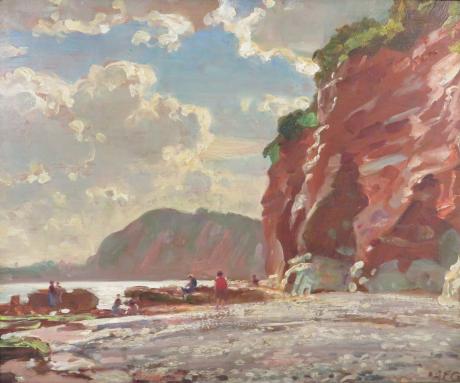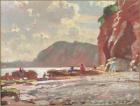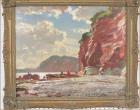with initials "AEC" lower left
The painting shows beach goers walking and rock pooling at low tide on the Chit Rocks which are the remenants of a Cliff-Height Sea Stack destroyed in the severe 1824 storms, (a one in about 250 year event). The Jacob's Ladder promonontory might develop into a similar stack although it is currently well protected.
Private Collection, Sidmouth
“Farewell, seductive Sidmouth by the sea older and more exclusive than Torquay : you’re the town for me!” so says Sir John Betjeman in "Bejtemans England".
Sidmouth is a town situated on the English Channel coast in Devon, South West England, 14 miles (23 km) east of Exeter. In 2004, it had a population of about 15,000, of whom 40% were aged 65 or over. By the time of the 2011 census the population was 12,569. It is a tourist resort and a gateway to the Jurassic Coast World Heritage Site. A large part of the town has been designated a conservation area. Sidmouth appeared in the Domesday Book as Sedemuda. Like many such settlements, it was originally a fishing village. Although attempts have been made to construct a harbour, none has succeeded. A lack of shelter in the bay prevented growth as a port.
Emmanuel Lousada, who founded the resort. The Jewish businessman recognised the physical beauty and potential of what was then a small port nestling on the mouth of the River Sid. He bought up as much land as he could in the late 1700s and set about developing a genteel, yet exotic holiday venue. He built the first cottage orné - a large house dressed up as a cottage and often thatched with pretty bargeboards, which appealed to the holidaying aristocracy of the day. Lousada was a brilliant publicist and attracted an ever- widening circle of grandees to build their own holiday houses a little above and away from the sea. They now form the best collection of cottages ornés in the country.
When the Duke and Duchess of Kent, with their baby daughter Victoria, the future Queen, took Woolbrook Cottage for their holiday, it sealed Sidmouth's status in social and architectural terms.Sidmouth remained a village until the fashion for coastal resorts grew in the Georgian and Victorian periods of the 18th and 19th centuries. The numerous fine Georgian and Regency villas and mansions are now mostly hotels. In 1819, George III's son Edward, Duke of Kent, his wife, and baby daughter (the future Queen Victoria) came to stay at Woolbrook Glen for a few weeks. In less than a month he had died from an illness. The house later became the Royal Glen Hotel; a plaque on an exterior wall records the visit. In 1874, Sidmouth was connected to the railway network by a branch line from Sidmouth Junction, which called at Ottery St Mary and Tipton St John. This was dismantled in 1967 as a result of the Beeching Axe. Most of the route can still be traced and the Sidmouth railway station can still be found now although this is now a private property.
In 2008, Canadian millionaire, Keith Owen, who had vacationed in the town and planned to retire there, bequeathed the community's civic society, the Sid Vale Association, about £2.3 million upon learning that he had only weeks to live due to lung cancer. The bequest is to be used as a capital fund to generate an annual interest dividend of around £120,000 for community projects. Sidmouth lies at the mouth of the River Sid in a valley between Peak Hill to the west and Salcombe Hill to the east. It is surrounded by the East Devon Area of Outstanding Natural Beauty and is on the Jurassic Coast, a World Heritage Site, and the South West Coast Path. The red-coloured rock indicates the arid conditions of the Triassic geological period. Erosion remains a serious concern east of the mouth of the Sid. The cliffs have been heavily eroded, threatening homes and the coastal footpath. The wide esplanade has been a prominent feature since Regency times. A series of southwesterly storms in the early 1990s washed away much of the shingle beach protecting the masonry. A series of artificial rock islands was constructed to protect the sea front, and tons of pebbles were trucked in to replace the beach.
The parish church is dedicated to St Giles & St Nicholas; it was rebuilt in 1860. Of the medieval structure only the 15th century tower was retained; the architect was William White. Oddments of Norman and later stonework were included in the rebuilding. Features of interest include the reredos by S. S. Teulon and the Duke of Kent Memorial Window which Queen Victoria gave in 1867. Parts of the original fabric such as the windows were reused by the historian Peter Orlando Hutchinson in building a folly adjoining his house. He was also responsible for saving the stained glass in the vestry. The folly is the Old Chancel in Coburg Terrace which was started by Hutchinson in 1859, in protest over the destruction of the original church fabric during rebuilding.
The church of All Saints, also Anglican (Taylor, architect, 1837), is in the Early English style with lancet windows and "oddly clumsy" pinnacles. There were also Unitarian, Wesleyan (later Methodist) and Congregational chapels; the Unitarian chapel was founded in the 17th century by Presbyterians and the Wesleyan and Congregational ones in 1837 and 1846 respectively. Sidmouth is home to the Norman Lockyer Observatory and Planetarium, located on Salcombe Hill. The facility, completed in 1912, fell into disuse but was saved from demolition by the appeals of enthusiasts to East Devon District Council. The observatory now operates as a science education project and is open to the public.
Sidmouth has featured in various literary works, e.g. as "Stymouth" in Beatrix Potter's children's story The Tale of Little Pig Robinson (1930) in which the author included views of the beach and other parts of the Devon countryside. In Thomas Hardy's Wessex it is the inspiration for "Idmouth". "Baymouth" in William Makepeace Thackeray's Pendennis, and "Spudmouth" in the The Merry Adventures of Robin Hood by Howard Pyle, are both based on the town. The poet Elizabeth Barrett lived in the town from 1832 until 1835.Sidmouth has been the setting for television shows, most recently an ITV adaptation of Agatha Christie's Marple in Summer 2005. It was a favourite spot for Sir John Betjeman. He chose it as the subject of the first programme of the television series John Betjeman in the West Country that he wrote and presented in 1962. The script takes the form of an extended poem and was republished in 2000 as a short book. Sidmouth, specifically the area of rock pools around Jacobs' Ladder, is also used as the location for H. G. Wells' The Sea Raiders.
Alfred Egerton Cooper was an internationally acclaimed portraitist who also painted landscapes, coastal and harbor views of Great Britain and horse racing scenes. His style emphasized deep realism, and his glittering career hinged on the glamour he imparted to European royalty, Buckingham Palace, the British Parliament and rich and powerful public figures. Ambitious and technically skilled, he fulfilled countless royal commissions and had some of the most powerful and notable people in Britain sit for portraits. Born in 1883, he studied at the Bilston School of Art and on a scholarship at London’s Royal College of Art, from which he graduated in 1911. He first exhibited at the Royal Academy at the age of 18 and would continue exhibiting throughout his career, he exhibited for the first of 40 times at the Royal Academy.
Following his graduation, Cooper entered a competition for which John Singer Sargent (1856-1925), a cosmopolitan expatriate internationally celebrated for grand-manner portraits, notable landscapes, and genre scenes, was on the board of judges. Astonished by the young artist’s work, Sargent asked Cooper to work with him in his famous Tite Street studio in Chelsea, which had once belonged to James McNeill Whistler (1834-1903). Cooper spent about a year as Sargent’s assistant, painting backgrounds and details for his paintings. He was elected to the Royal Society of British Artists in 1914.
During World War I, Cooper served in the well-known 28th County of London Volunteer Regiment, the Artists Rifles, and his sight in one eye was damaged by chlorine gas. At the end of the war, he was made an official artist of the Royal Air Force, and he became an expert in the art and technique of large-scale aerial camouflage and sketching and painting landscapes from the air. Some of his works are now in the Royal Air Force Museum and London’s Imperial War Museum. At the end of World War I Cooper was appointed as Official War Artist to the R.A.F. He became an expert in the art and technique of large scale aerial camouflage, sketching and painting landscapes from a variety of aircraft. Some of his related work is in London's Imperial War Museum.
In 1917, Cooper met the woman who would become his wife near Romford, Essex, where her parents entertained local officers at their home. They had a son, Peter C. Cooper, who would become an artist in the United States.
The elder Cooper’s career continued to develop as he became known for both portraits and landscapes. He exhibited his work in Paris and London, and in 1921, his painting London was a notable feature of the Royal Academy of Arts Summer Exhibition. Three years later, he won an Honorable Mention at the Paris Salon. He also exhibited at the Walker Art Gallery in Liverpool, the Royal Institute of Oil Painters, the Royal Institute of Painters in Water Colours and Goupil Gallery. In 1940, he painted King George VI, and his 1943 portrait of Winston Churchill was reproduced as a poster intended to rally the English people during World War II.
Cooper made annual excursions to the American midwest in the 1960s. He died in 1974.
Chronology
1883 Born in Tettenhall, Staffordshire, U.K.
1911 Graduated on a scholarship from London’s Royal College of Art
1914 Elected to Royal Society of British Artists
1914-18 Served as captain in Artists Rifles during World War I
1921 Copper was elected ARBA and a full member two years later.
1939 Commissioned to paint two portraits of King George VI
1943 Profile For Victory, a portrait of Winston Churchill, exhibited at Royal Academy and later published as a morale-boosting poster
1954 Commissioned to paint Light Brigade Ball, centennial celebration honoring Charge of the Light Brigade at Balaklava during the Crimean War
1960 Made annual excursions to the American midwest
1974 Died
Collections
London’s Imperial War Museum
Minneapolis Institute of Arts, Minnesota
National Portrait Gallery, London, UK
Royal Air Force Museum
Exhibitions
Chenil Galleries,
Goupil Gallery, London, UK
GI
Leger Gallery, London, UK
Leicester Gallery, London, UK
Liverpool, UK
Manchester City Art Gallery
Paris Salon
RBA
Royal Academy of Arts
Royal Institute of Oil Painters
Royal Institute of painters in Water Colours
RSA
Walker Art Gallery, Liverpool
Memberships
Chelsea Arts Club
The Carlton Club, London, UK



